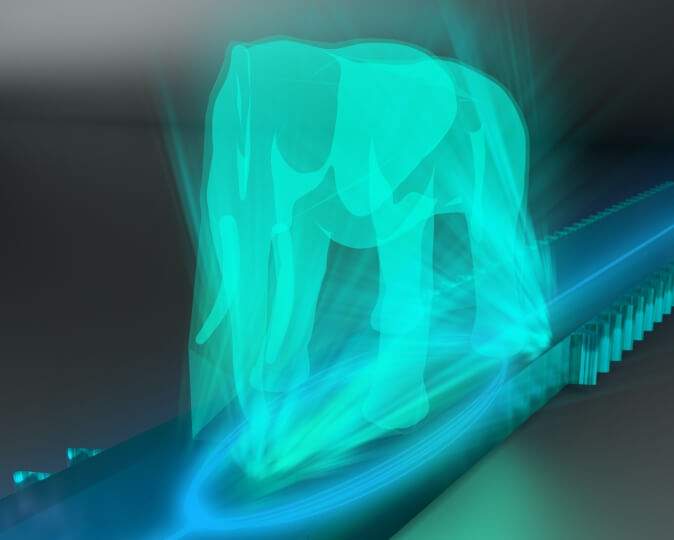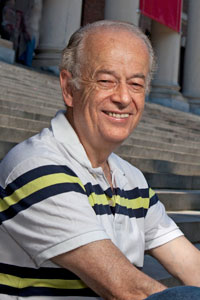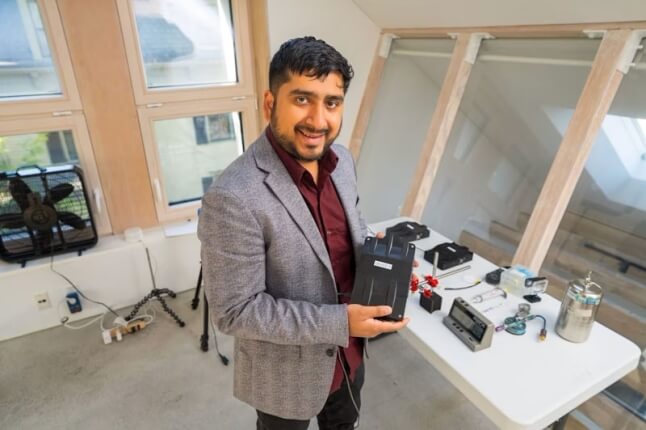News
Designer landscape of localized light in the shape of an elephant. Guided light is molded by bouncing back and forth between two mode converters. (Image courtesy of Back Bay Studios/Harvard SEAS)
There are many types of light — some visible and some invisible to the human eye. For example, our eyes and brain don’t have the tools to process ultraviolet light when it hits our eyes, making it invisible. But there is another type of light that is invisible simply because it never reaches our eyes. When light hits certain surfaces, part of it sticks and remains behind rather than being transmitted or scattered away. This type of light is called near-field light.
Today, near-field light is mostly used for ultra-high-resolution microscopy, known as the near-field scanning optical microscopes (NSOM). However, near-field light also has untapped potential for particle manipulation, sensing, and optical communications. But since near-field light doesn’t reach our eyes like far-field light does, researchers haven’t developed a comprehensive toolkit to harness and manipulate the near field.
“Today, we have a lot of tools and techniques to design what far-field light looks like,” said Vincent Ginis, an Associate in Applied Physics Harvard John A. Paulson School of Engineering and Applied Sciences (SEAS). “We have lenses, telescopes, prisms and holograms. All these things enable us to sculpt freely propagating light in space.”
Ginis is also a professor at the Vrije University of Brussel.
Now, SEAS researchers have developed a system to mold near-field light — opening the door to unprecedented control over this powerful, largely unexplored type of light. The research is published in Science.
“Over the years, our group has developed new powerful techniques to structure propagating light using subwavelength-patterned metasurfaces,” said Federico Capasso, the Robert Wallace Professor of Applied Physics and Vinton Hayes Senior Research Fellow in Electrical Engineering, and senior author of the paper. “With this work, we show how to structure the near field at a distance, opening exciting opportunities in science and technology.”
In order to manipulate near-field light, the researchers developed a device in which light confined to a waveguide bounces back and forth between two reflectors. After each bounce it changes mode, meaning it propagates with a different spatial pattern. With multiple bounces, these patterns add up to generate a complex light intensity profile along the waveguide. The near field light near the surface of the waveguide also changes. When all the different patterns of the near-field light are superimposed on each other, a specific shape is created. The researchers can pre-program that shape by tailoring the amplitude of the modes of the bouncing light.
“The coexistence of all these modes can be designed to create near-field landscapes at will on the surface of the device,” said Marco Piccardo, a research associate at SEAS and co-author of the paper. “The shape of the landscape is determined by the combined properties of the cascading light.”
A schematic of a near-field landscape device. Light confined to a waveguide bounces back and forth between two converters (blue), which changes the light's mode or pattern. With multiple bounces, these patterns add up to generate a near-field landscape on the surface of the waveguide (red).
“It’s a bit like music,” said Ginis. “The music that you are hearing is the superposition of many notes or modes assembled in patterns conceived by the composer. One note alone isn’t much but taken together you can generate any type of music. While music operates in time, our near-field generator operates in three-dimensional space and the extra intriguing aspect of our device is that one note generates the other.”
Importantly, this molding process happens remotely, meaning no part of the device directly interacts with the near-field light. This reduces interference, which is important for applications such as particle manipulation, and is a major departure from current local methods of sculpting near fields such as shining light on metallic tips and nanoparticles.
To demonstrate their design, the researchers molded near-field light into the shape of an elephant. Or, more specifically, an elephant inside a boa constrictor, an homage to the play on dimensions in Antoine de Saint-Exupéry’s classic The Little Prince.
Reconstructions of the near-field landscape generated by the device. The shape in the center was inspired by an illustration from Antoine de Saint-Exupéry’s classic The Little Prince.
The researchers also shaped the light into a curve, a plateau and a straight line.
"This research provides a new path towards unprecedented three-dimensional control of near-field light,” said Capasso. “It is a portent of the exciting discoveries and technology developments I expect to come out of this work in the future.”
The Harvard Office of Technology Development has protected the intellectual property relating to this project and is exploring commercialization opportunities.
The paper was co-authored by Michele Tamagnone, Jinsheng Lu, and Simon Kheifets of SEAS and Min Qui of the School of Engineering at Westlake University in Hangzhou, China. It was supported in part by the Air Force Office of Scientific Research under grant no AFOSR FA9550-14-1-0389. The Harvard authors also acknowledge the support of Harvard University Center for Nanoscale Systems (CNS), a member of the National Nanotechnology Infrastructure Network (NNIN).
Topics: Applied Physics, Optics / Photonics
Cutting-edge science delivered direct to your inbox.
Join the Harvard SEAS mailing list.
Scientist Profiles
Federico Capasso
Robert L. Wallace Professor of Applied Physics and Vinton Hayes Senior Research Fellow in Electrical Engineering
Press Contact
Leah Burrows | 617-496-1351 | lburrows@seas.harvard.edu






